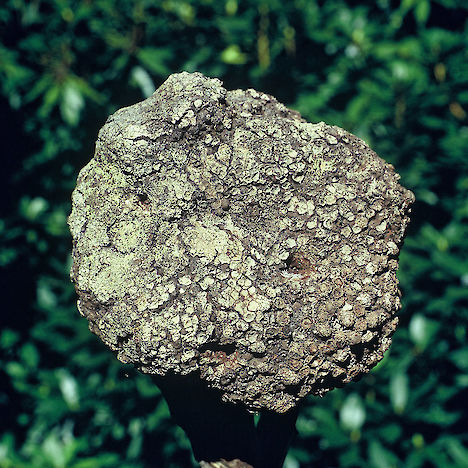Threat category:
Threatened: Nationally Vulnerable?Regions:
Northland, Auckland, Waikato, Bay of Plenty, Gisborne, Hawkes Bay, Manawatu-Wanganui, Taranaki, WellingtonDistribution:
North Island
Key Features
- A root parasite forming a rounded, warty growth on the roots of parasitised plants. These can reach 50 cm in diameter, and occur just below the ground surface.
- Wood rose lacks leafy shoots, but produces many fleshy flowering shoots to 20 cm long, which are clad in pinkish scale leaves. When these shoots reach the ground surface, clusters of many small flowers open, which are adapted for pollination by the short-tailed bat.
- The flowering shoots leave distinctive circular scars on the warty underground part of the plant, which differentiate wood rose from galls formed by bacterial infections.
Distribution and Habitat
- North Island, from sea level to 1200 m. Generally in secondary forest where it parasitises the roots of a wide range of small trees, and some larger trees including broadleaf and beech.
- Also occurs on the outer fringes of montane forest.
- It generally occurs in well-drained but damp sites, typically at the heads of small streams.
Threats
- Habitat modification and loss.
- Possum and rodent browse of inflorescences.
- Loss of pollinators and seed dispersers.
- Trampling by stock.
- Collection.
Management Opportunities
- Survey for new locations.
- Mark known sites.
- Protection of habitat – retain secondary forest cover at known sites.
- Possum and rodent control by poisoning or trapping.
- Exclude stock from known sites.
- Ensure that forest owners are aware of potential habitats and can recognise the species.
Monitoring Options
- Check existing populations for browse damage during flowering and fruiting (January-May).
- Report new locations to DOC, NZPCN.
Further Information and Support
- New Zealand Plant Conservation Network (NZPCN). http://www.nzpcn.org.nz
- References
- Dopson et al. (1999). The conservation requirements of New Zealand’s nationally threatened vascular plants. Threatened Species Occasional Publication 13. Department of Conservation, Wellington.
- Poole & Adams (1994). Trees and shrubs of New Zealand. Maanaki Whenua Press, Lincoln.
- Wilson & Given (1989). Threatened plants of New Zealand. DSIR Publishing, Wellington.
- Peter de Lange, Peter Heenan, David Norton, Jeremy Rolfe and John Sawyer (2010). Threatened Plants of New Zealand. Canterbury University Press, Christchurch. 472 pp.


